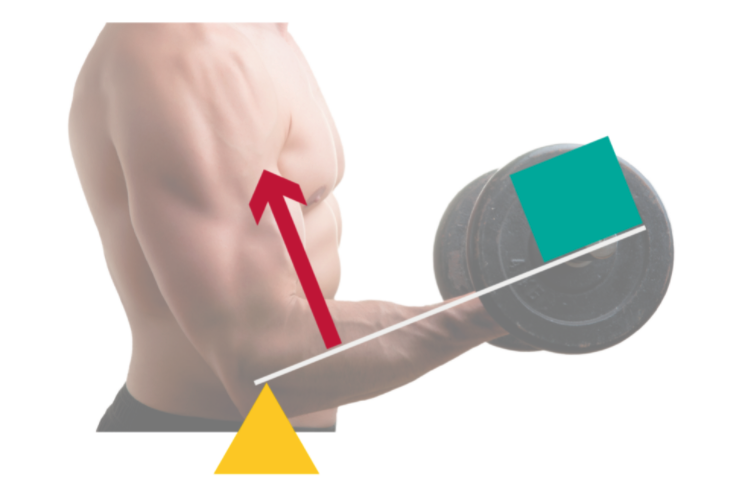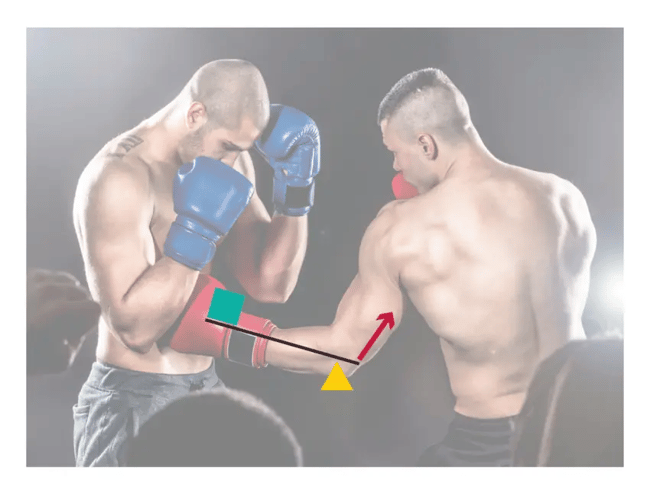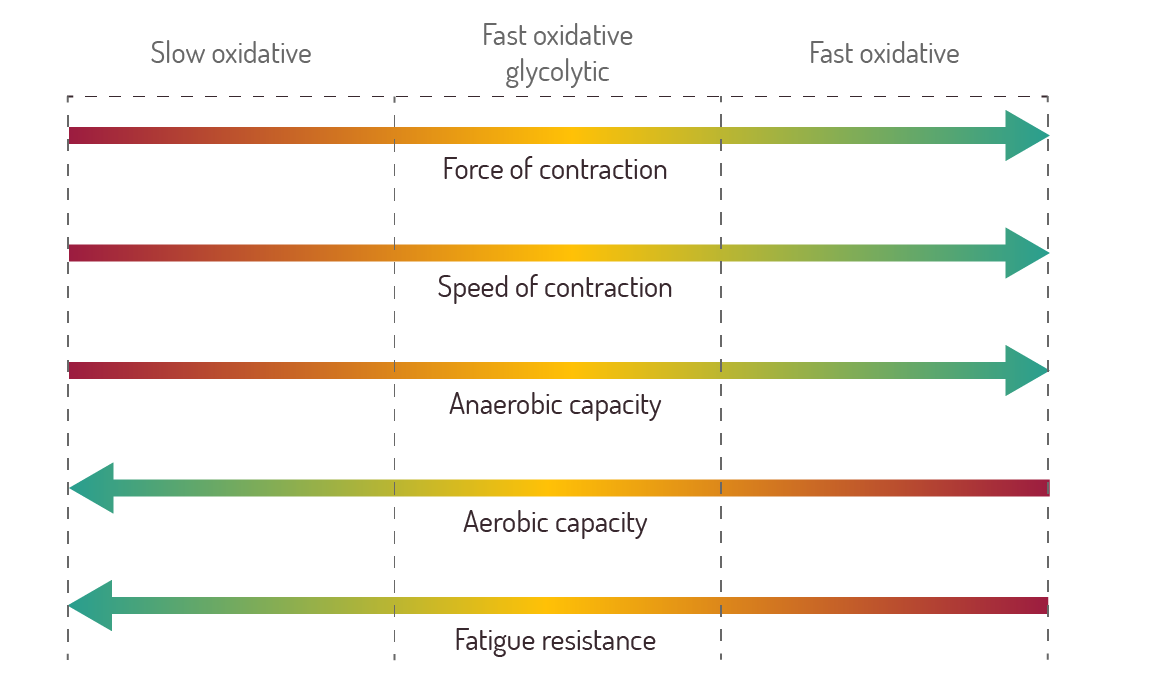Ten most common misconceptions in PE theory teaching
In a rush? Jump to the specific section.
➚ Misconception 1: “Energy production”
➚ Misconception 2: “Elbow extension is a third class lever”
➚ Misconception 3: “The golden triangle is the commercial relationship between sport, the media and sponsors”
➚ Misconception 4: “There are three muscle fibre types”
➚ Misconception 5: “Diffusion is movement of gases from high to low concentration.”
➚ Misconception 6: “When we start to exercise, breathing gets faster”
➚ Misconception 7: “The ankle is not a hinge joint”
➚ Misconception 8: “Athletes increase intensity of training by doing more reps or sets”
➚ Misconception 9: “Weather is an environmental stimulus”
➚ Misconception 10: “The aorta exits the bottom of the heart”
Misconception 1: “Energy production”
Energy cannot be produced nor destroyed, yet in PE classrooms up and down the land, PE teachers use the phrase “energy production” when teaching aerobic and anaerobic energy pathways at GCSE level or when teaching the three energy systems and energy continuum at A-Level. This is a misconception that we can change overnight. In future lessons, documentation and questions, please remove the phrase “energy production” and replace it with either:
- Energy release
- Energy transfer
Energy transfer is a particularly useful phrase to use, as students (typically at the start of year 10) often struggle to understand energy stores and energy transfer as their first learning topic on GCSE physics (or physics within combined science). If PE teachers support learners to understand that the aerobic energy pathway, say, transfers energy from a potential energy store (glycogen or fat) into a kinetic energy store (movement), we are directly linking our teaching to that of physics teaching and we are improving the chances of students genuinely understanding both topics in both subjects. In fact, by teaching energy transfer in PE, we are also addressing the weakness I have typically seen in physics teaching which is a lack of application of energy transfer to the real world.
Misconception 2: Elbow extension is a third-class lever
I once got attacked on Twitter for clarifying that elbow extension is NOT a third-class lever. In fact elbow extension, during an isotonic concentric contraction such as a throw, is most definitely a first-class lever.
The reason that confusion has occurred is largely down to the OCR exam board stating that the elbow is a third-class lever. This is only partially true. Elbow flexion, during an isotonic concentric contraction is a third-class lever. This is because the insertion point of the biceps (brachii) is on to the radius and this insertion lies between the elbow joint (fulcrum) and the object being lifted (load).
 However, elbow extension is a first class lever for the equivalent reasons. The triceps (brachii) inserts onto the point of the ulna (olecranon) and this insertion sits outside the elbow joint (fulcrum).
However, elbow extension is a first class lever for the equivalent reasons. The triceps (brachii) inserts onto the point of the ulna (olecranon) and this insertion sits outside the elbow joint (fulcrum).

This, in turn, means that the fulcrum is between the load and the effort and that elbow extension is a first-class lever.  Or
Or
By way of a bit of intrigue, I thought I would also pose a logic question to teachers: given your understanding of muscle insertion points and the elbow, what classification of lever is operating in the following circumstances?
Misconception 3: “The golden triangle is the commercial relationship between sport, the media and sponsors.”
Now, you may feel I am being picky here but I want to make an important point: the golden triangle is not a relationship between sport and these other parties. It is a relationship between elite sport and the other parties. The golden triangle only operates effectively, with one exception, when sport is considered elite and is highly desirable to consumers. Let’s take the sport of boxing. Elite boxing is highly commercialised with very lucrative pay-per-view events attracting huge audiences and lots of sponsorship. However, amateur boxing or even lower ranking professional boxing struggles desperately to stay afloat because there is very little commercial interest. Let’s take another example: elite men’s football has, for years, benefitted from the golden triangle because elite performances by teams like Chelsea FC, Manchester United, Real Madrid, Bayern Munich, etc. have been hugely appealing to the consumer audience. However, even in the leagues just below the Premiership or equivalent, the golden triangle fails to operate effectively. The most renowned example of this is when the subscription service (now free) ITV Sport Channel paid over £300m for rights to the English football league division 1, 2 and 3 (not the Premier league) and a midweek fixture between two league teams attracted a TV audience of only 357 people. Shortly after, ITV Sport Channel tried to reduce their £300m bill by £150m and the Football League sued ITV Sport Channel for breach of contract. ITV Sport Channel went bust.
So, why did this happen? Simply put, ITV Sport Channel, perhaps bravely, perhaps stupidly, tried to recreate the golden triangle with non-elite sport. As a result, the model failed and ITV Sport closed down.
Now, I mentioned an exception above. This exception is a modern one and relates to the capacity of modern performers, elite or otherwise, to build their own media outlets. An excellent example of this is Jake Paul. He is a YouTuber and influencer with a massive following and has transitioned to professional boxing. Despite Jake not (yet) being an elite athlete, he is currently estimated to be the fifth highest earning boxer in 2021 only earning less than Canelo Alvarez, Anthony Joshua, Tyson Fury and Floyd Mayweather. Interestingly, Floyd Mayweather is only above him in 2021 earnings because he fought out a drawn exhibition bout against Jake Paul’s brother Logan, another non-elite boxer.
Misconception 4: “There are three muscle fibre types.”
This is taught as absolute gospel in PE classrooms up and down the land but, bluntly, it just isn’t true. There are many, many thousands of different muscle fibre types with slightly different characteristics and the three that we tend to teach are generalised categories. It is absolutely reasonable to teach students the following facts:
- There are three categories of muscle fibres based on the characteristics of the fibre.
- All muscle fibres within a motor unit have exactly the same characteristics.
This illustration might help the intuition of the concept:

I chose to focus on the functional characteristics, but it would also be interesting to follow the same process for structural. Consider size and density of mitochondria: this could be seen in contrast to the size of the fibre which would be far greater for fast glycolytic fibres.
Misconception 5: Diffusion is movement of gases from high to low concentration.
Again, I am in danger of being picky here but I feel this is an important point. Diffusion is not movement of gases from high to low concentration. Rather, it is the NET movement of gases from high to low concentration. This teeny word “net” matters because it reveals the true intuition of this topic which is kinetic theory or, if rendered down further, simply probability. Net means total or overall. What I am insisting on here is that PE teachers accept that oxygen, say, moves also from low to high concentration at the alveolus but in much lower quantities than from high to low. This is why it is “net movement”. The trend is for more oxygen, say, to move from high to low concentration purely because the molecular oxygens are moving randomly and because there is a greater quantity on one side of the partially permeable membrane to the other (concentration gradient), the net movement is from high to low concentration.
My lesson from GCSE biology on diffusion might be helpful:
Misconception 6: “When we start to exercise, breathing gets faster.”
The human body is more than capable of increasing breathing frequency but this categorically does not happen at the onset of exercise. When work intensity rises, our breathing depth increases through the increased strength of inspiratory muscular contraction and it is only when an increased breathing depth cannot sustain sufficient aerobic energy transfer that breathing frequency will increase. In other words:
When we start to exercise, our breathing depth increases.
At higher intensities of exercise, breathing frequency then increases.
It is also worth noting that the respiratory control centre in the brain (medulla) has two sub-domains. The inspiratory control centre controls both inspiration and expiration. This is the case because it is the inspiratory control centre that stimulates the expiratory control centre to cause expiration to become active. Expiration is active when expiratory muscles like the internal intercostals and the rectus abdominis contract during expiration. It is this action, at higher intensities of exercise, that increases breathing frequency.
Misconception 7: “The ankle is not a hinge joint.”
It is. Done. 😋
Misconception 8: “Athletes increase intensity of training by doing more reps or sets.”
Any addition of reps and/or sets is a change in time. In other words, moving from 3 sets of 12 reps to 4 sets of 15 reps is a change in the first T of FITT not the I. Intensity can only be adjusted in the following ways:
- Increase/decrease in %HRmax
- Increase/decrease in %1REPmax
- Increase/decrease in % of range of movement
- Increase/decrease in force
- Increase/decrease in speed
- Increase/decrease in incline
Time can be adjusted with any of the following:
- Increase/decrease in overall session length
- Increase/decrease in reps
- Increase/decrease in sets
- Increase/decrease in time spent at a station (circuits)
- Increase/decrease in time spent recovering between sets
It is incredibly common for students to try to increase intensity by increasing reps, say, and teachers need to ensure that they do not support this misconception including not awarding marks on practice papers and mocks.
Misconception 9: “Weather is an environmental stimulus.”
There have been countless occasions where a student is answering a question about the environmental continuum and they have stated that the weather is an environmental stimulus. The idea goes that if it’s raining, a shot putter would need to adapt their technique for wet conditions. This fails to meet the concept of more open skills. Open skills, such as defending in any sport, are open because the sporting context is unpredictable and the skill of defending has to be adapted to suit the specific scenario the defender finds themselves in. Consider the shot putter again. This is clearly a closed skill. If it was raining, the shot putter would not change their technique. Rather, they would use a towel to dry their hands and the shot and then apply more chalk before putting in exactly the same way.
In order for weather to be an environmental factor, the weather would need to change during the throw and then do so suddenly enough and to such a degree that the putter would adapt their technique while they were putting. For this reason, “weather” is not a high quality answer regarding the environmental continuum. Worryingly, I have seen more than one exam board crediting “weather” as worthy of a mark in formal exams. I categorically reject this and I ask the exam boards to up their game to the benefit of the PE teaching sector who, largely, follow the rhythms of exam board mark scheme content for guidance on what is correct and incorrect.
Environmental stimuli (list not exhaustive)
- Position/action of a teammate
- Position/action of an opponent
- Flight of a projectile
- Starter signal (gun, beep)
Not environmental stimuli (list not exhaustive)
- Weather
- Score in the match
- Emotions
- Tactics
Misconception 10: “The aorta exits the bottom of the heart”
I have seen many depictions of the heart that seem to show that the aorta exits the heart below the left ventricle. It doesn’t. The aorta is the exit point for blood being ejected from the left ventricle but this is achieved through ventricular systole which forces blood upwards outwards of the aorta at the top of the heart.
The reason that teachers sometimes depict blood leaving the bottom of the heart is presumably because the aorta does arch downwards in order to deliver oxygenated blood to the inferior portion of the body. However, blood categorically does not exit the heart at the bottom and teachers should guide students to understand this by teaching about the aortic arch.
In order to support you with this, a nice titbit of knowledge to share with students is that cardiac muscle, when observed microscopically, is structured in an almost-vortex-like structure. If you imagine taking a wet flannel and twisting it to squeeze every last drop of water from it, the heart does the same but does so in the upwards direction. So, the heart literally twists in on itself (slightly) in order to wring the maximum volume of blood possible up and out of the aorta at the top of the heart before the aortic arch shifts a majority of this blood downwards and behind the heart on the way to the legs, reproductive organs, stomach etc…
Conclusion
As always, I want to thank you for reading the blog. I write it with real teachers in mind. On posts like this one, there is always the possibility of sounding critical or judgemental. This is not my aim. In fact, I have personally got most of these points above wrong at some point in my career. I feel that, in the spirit of sharing and honesty, there is much to be learned and I am excited about the possibility of colleagues reading what has been written.
Have a lovely day.
%20Text%20(Violet).png)


